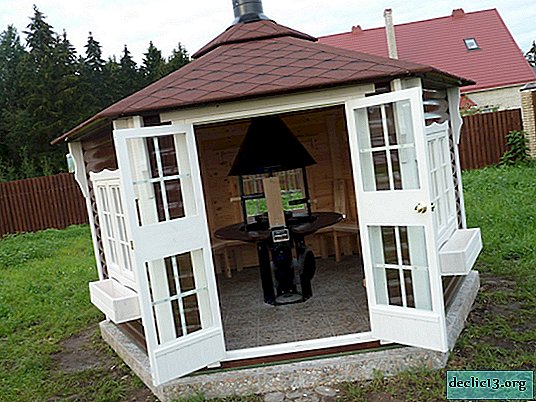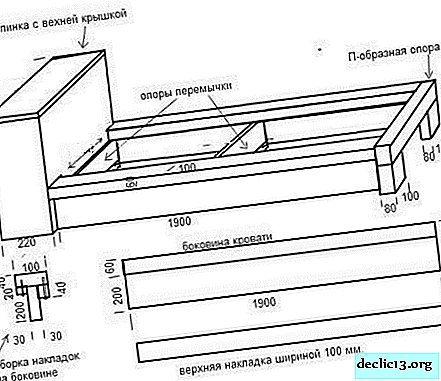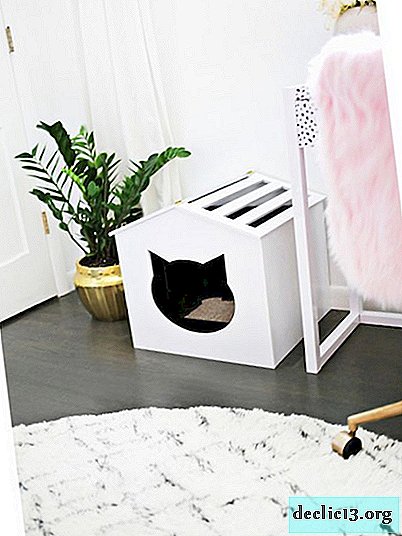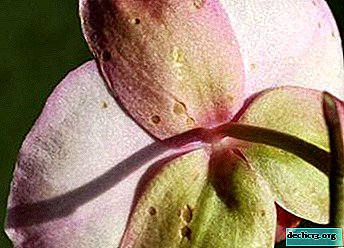Description of the species Schlumbergera truncata, features of reproduction, planting and care of a flower
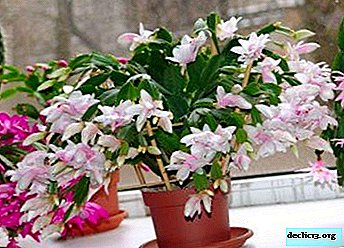
Schlumbergera truncate - the original Decembrist variety. It is very popular among gardeners because of its unpretentiousness in care, resistance to diseases, a rich range of colors. In addition, when propagating plants, special difficulties will not arise even for a beginner grower.
In this article, you will learn how to properly care, propagate, and transplant this plant. And also we will tell what difficulties the flower grower growing a truncate schlumbergera can face.
View description
Schlumbergera truncata (Schlumbergera truncata) - a type of zygocactus belongs to the epiphytes of the cactus family. Natural habitat - Brazil, South America. They grow in tropical forests on trunks and tree branches.
Reference! In Europe, Schlumbergera varieties became widespread in the 19th century.There are many hybrid successors of the genus Schlumbergera, among them the truncated zygocactus. The flower is considered a perennial. It grows with a squamous bush, has no leaves.
The bush grows to 50 cm in diameter. Shoots weakly branching, arched, saturated - green.
 Zygocactus truncate is called truncated due to the structural features of flat stems. Leaf-shaped stems are pointed, with 2-4 small teeth along the edges.
Zygocactus truncate is called truncated due to the structural features of flat stems. Leaf-shaped stems are pointed, with 2-4 small teeth along the edges.
The stems are small in length, each segment is 4 - 5 cm, in width - up to 2 - 2.5 cm. 2 new shoots grow from each tip of the shoot. Each segment in the process of stem growth divides into 2. At the very tip of the segment, small brown spines grow.
The flowers are bilateral, arranged symmetrically, grow in the form of a beveled tube. Petals slightly bent back. In diameter, the flowers are small, up to 2 - 2.5 cm, in length up to 6 - 8 cm. Stamens are long, straight, protrude beyond the corolla. The plant blooms in white, pink, lilac, lavender, purple. Multicolor species are also found. It blooms luxuriantly and generously.
Fruits - smooth, reddish berries, 1 cm in length, ripen in spring. The root is poorly developed, superficial.
How long do they live and when do they bloom?
The Decembrist truncated by right is considered a long-liver. Under special conditions and regular updating of the bush, they can live in botanical gardens and nurseries for more than 100 years. In apartment conditions, due to its endurance and unpretentiousness, a flower can grow and develop up to 20 years.
This species always blooms in the winter, most often in December. In late autumn, the formation of buds begins; during this period, good watering is desirable as the substrate dries. The optimum air temperature is up to 18 - 20 ° С. With a sharp drop or drop in temperature, flowering does not occur.
Important! Avoid lowering air humidity; dry air can cause buds to drop. Also, no need to rearrange or rotate the pot at this time. Unfolding the flower slows down flowering.To strengthen the stems and splendor of flowering, it is recommended to first pinch off the tops of the shoots. Proper and timely pruning increases the life of the truncated Decembrist, forms a voluminous lush bush with abundantly flowering shoots.
At the time of bud formation, it is advisable to water the flower with a weak tea solutionand mulch the soil in the pot with tea leaves.
Trumpeter Schlumberger Care
- Schlumbergera truncate prefers soft, diffused light, direct sunlight is contraindicated in the flower.
- The optimum temperature of growth and development of a flower is 18 - 25 ° С.
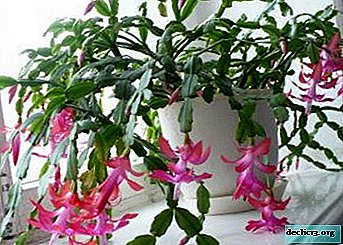 During the growth period - in spring and summer, it is advisable to feed a truncated Decembrist with special mineral fertilizers for cacti and succulents. Fertilizers are applied no more than 1 time in 10-14 days.
During the growth period - in spring and summer, it is advisable to feed a truncated Decembrist with special mineral fertilizers for cacti and succulents. Fertilizers are applied no more than 1 time in 10-14 days.- In summer, in addition to regular watering, it is recommended to spray and wash the bushes with warm clean water.
Overmoistening of the soil should not be allowed; the root may rot.
- In the fall there comes a period of rest. Watering must be reduced, watering should be in small doses not more than 1 time per week. Permissible air temperature at this time is up to 18 ° С.
- Intensive watering, spraying, additional fertilizing resumes in early December.
Breeding
The truncated Decembrist propagates in several ways.
Seeds
The method is complex, long-term, rarely used in home practice. Seeds are purchased only in the store, it is impossible to get them yourself. Sown seeds in separate low containers, germination occurs in greenhouse conditions.
Attention! The period of seed germination is 1-3 months. Seedlings require constant care, pinching, then the grown sprouts dive into small pots.Cuttings
The easiest and most affordable method of reproduction. Truncated Schlumbergera - cuttings root well at any time of the year.
Before the procedure, the cuttings must be dried in partial shade for 2 days, treated with root hormone.
- The processes penetrate slightly into the substrate, you can not deepen, just put on supports or along the walls of the container.
- Cuttings are usually covered with a film or a glass jar.
Rooting pass quickly, within 3 to 4 weeks.
Vaccination
The method is used to create standard forms.
- Cuttings of the truncated Decembrist are grafted onto other cacti - gilocerius, selenicerius, peirescia.
- The place of vaccination is fixed with a thread, the branches are placed on supports.
Such manipulations are possible only for experienced specialists; certain knowledge and skills are required.
Transfer
Young bushes of the truncated Decembrist are transplanted annually. Adult flowers are updated less often - 1 time in 3 to 4 years. The pot is required shallow, wide, 2-3 cm larger in diameter than the previous one with drainage holes.
 The substrate requires a light, loose, nutritious. Often, ready-made peat soil is used for transplantation. You can prepare a special mixture:
The substrate requires a light, loose, nutritious. Often, ready-made peat soil is used for transplantation. You can prepare a special mixture:
- sheet earth;
- turf land;
- crushed charcoal;
- sand.
All components are mixed in equal parts. Drainage is mandatory - crumb brick, pebbles.
Transplanting after flowering. It is recommended to use the transshipment method, preservation of an earthen coma prevents damage to the root, the flower takes root more easily and quickly.
Content difficulties
- It is important to prevent hypothermia of the flower. The stems become brown in color, you should adjust the air temperature or rearrange the pot in a warmer and brighter place.
- If the leaves have lost their elasticity and freshness, become wrinkled and lifeless, the irrigation regime is violated. With a lack of moisture, you need to add spraying, increase the amount of water when watering.
- From an excess of moisture, a truncated Decembrist can drop leaves. Watering should be suspended for several days, if necessary, replace the top layer of the substrate. It is necessary to study the root - cut off the rotted areas, transplant the flower, treat the soil and bush with fungicides containing chlorothalonin.
- You should also observe moderate doses of fertilizer. Weak roots can not absorb a large amount of mineral fertilizers, from an overdose of a flower can die.
- From fungal infections - Fusarium, phytophthora, which affect the root and root of the neck, will save the drug "Vitaros".
- In the treatment of bacterial diseases, fungicides are usually not used. It will require urgent pruning, transplanting or grafting of healthy stems. Slices are treated with charcoal or a weak solution of potassium permanganate.
Important! During treatment, the infected flower must be isolated from other plants - the infection spreads rapidly.
- Truncated Schlumberger is quite hardy in relation to insects and pests. But with stagnant air humidity and a moist substrate, the leaves can be affected by aphids or scale insects. A bush treatment with soapy water will be required.
- For the prevention of diseases and pests, processing of the substrate and stems with foundationazole or a solution of Bordeaux fluid is required.
In order for the truncated Decembrist to delight with his festive flowering every winter, it is necessary to follow all the rules of care and "personal hygiene" of a tropical flower.

 During the growth period - in spring and summer, it is advisable to feed a truncated Decembrist with special mineral fertilizers for cacti and succulents. Fertilizers are applied no more than 1 time in 10-14 days.
During the growth period - in spring and summer, it is advisable to feed a truncated Decembrist with special mineral fertilizers for cacti and succulents. Fertilizers are applied no more than 1 time in 10-14 days.






